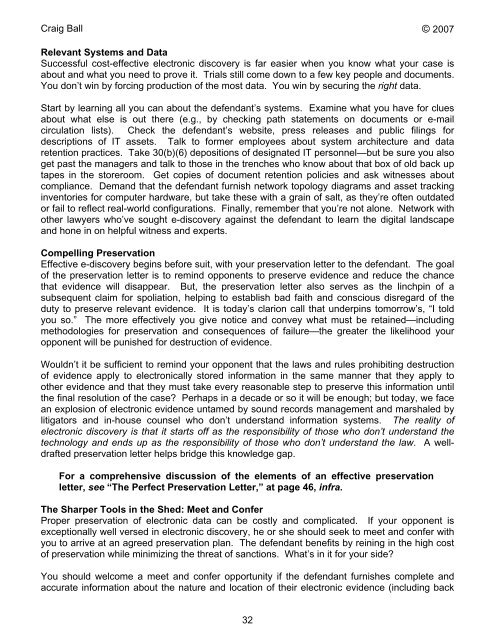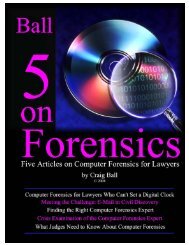Six Articles on Electronic - Craig Ball
Six Articles on Electronic - Craig Ball
Six Articles on Electronic - Craig Ball
You also want an ePaper? Increase the reach of your titles
YUMPU automatically turns print PDFs into web optimized ePapers that Google loves.
<strong>Craig</strong> <strong>Ball</strong> © 2007<br />
Relevant Systems and Data<br />
Successful cost-effective electr<strong>on</strong>ic discovery is far easier when you know what your case is<br />
about and what you need to prove it. Trials still come down to a few key people and documents.<br />
You d<strong>on</strong>’t win by forcing producti<strong>on</strong> of the most data. You win by securing the right data.<br />
Start by learning all you can about the defendant’s systems. Examine what you have for clues<br />
about what else is out there (e.g., by checking path statements <strong>on</strong> documents or e-mail<br />
circulati<strong>on</strong> lists). Check the defendant’s website, press releases and public filings for<br />
descripti<strong>on</strong>s of IT assets. Talk to former employees about system architecture and data<br />
retenti<strong>on</strong> practices. Take 30(b)(6) depositi<strong>on</strong>s of designated IT pers<strong>on</strong>nel—but be sure you also<br />
get past the managers and talk to those in the trenches who know about that box of old back up<br />
tapes in the storeroom. Get copies of document retenti<strong>on</strong> policies and ask witnesses about<br />
compliance. Demand that the defendant furnish network topology diagrams and asset tracking<br />
inventories for computer hardware, but take these with a grain of salt, as they’re often outdated<br />
or fail to reflect real-world c<strong>on</strong>figurati<strong>on</strong>s. Finally, remember that you’re not al<strong>on</strong>e. Network with<br />
other lawyers who’ve sought e-discovery against the defendant to learn the digital landscape<br />
and h<strong>on</strong>e in <strong>on</strong> helpful witness and experts.<br />
Compelling Preservati<strong>on</strong><br />
Effective e-discovery begins before suit, with your preservati<strong>on</strong> letter to the defendant. The goal<br />
of the preservati<strong>on</strong> letter is to remind opp<strong>on</strong>ents to preserve evidence and reduce the chance<br />
that evidence will disappear. But, the preservati<strong>on</strong> letter also serves as the linchpin of a<br />
subsequent claim for spoliati<strong>on</strong>, helping to establish bad faith and c<strong>on</strong>scious disregard of the<br />
duty to preserve relevant evidence. It is today’s clari<strong>on</strong> call that underpins tomorrow’s, “I told<br />
you so.” The more effectively you give notice and c<strong>on</strong>vey what must be retained—including<br />
methodologies for preservati<strong>on</strong> and c<strong>on</strong>sequences of failure—the greater the likelihood your<br />
opp<strong>on</strong>ent will be punished for destructi<strong>on</strong> of evidence.<br />
Wouldn’t it be sufficient to remind your opp<strong>on</strong>ent that the laws and rules prohibiting destructi<strong>on</strong><br />
of evidence apply to electr<strong>on</strong>ically stored informati<strong>on</strong> in the same manner that they apply to<br />
other evidence and that they must take every reas<strong>on</strong>able step to preserve this informati<strong>on</strong> until<br />
the final resoluti<strong>on</strong> of the case? Perhaps in a decade or so it will be enough; but today, we face<br />
an explosi<strong>on</strong> of electr<strong>on</strong>ic evidence untamed by sound records management and marshaled by<br />
litigators and in-house counsel who d<strong>on</strong>’t understand informati<strong>on</strong> systems. The reality of<br />
electr<strong>on</strong>ic discovery is that it starts off as the resp<strong>on</strong>sibility of those who d<strong>on</strong>’t understand the<br />
technology and ends up as the resp<strong>on</strong>sibility of those who d<strong>on</strong>’t understand the law. A welldrafted<br />
preservati<strong>on</strong> letter helps bridge this knowledge gap.<br />
For a comprehensive discussi<strong>on</strong> of the elements of an effective preservati<strong>on</strong><br />
letter, see “The Perfect Preservati<strong>on</strong> Letter,” at page 46, infra.<br />
The Sharper Tools in the Shed: Meet and C<strong>on</strong>fer<br />
Proper preservati<strong>on</strong> of electr<strong>on</strong>ic data can be costly and complicated. If your opp<strong>on</strong>ent is<br />
excepti<strong>on</strong>ally well versed in electr<strong>on</strong>ic discovery, he or she should seek to meet and c<strong>on</strong>fer with<br />
you to arrive at an agreed preservati<strong>on</strong> plan. The defendant benefits by reining in the high cost<br />
of preservati<strong>on</strong> while minimizing the threat of sancti<strong>on</strong>s. What’s in it for your side?<br />
You should welcome a meet and c<strong>on</strong>fer opportunity if the defendant furnishes complete and<br />
accurate informati<strong>on</strong> about the nature and locati<strong>on</strong> of their electr<strong>on</strong>ic evidence (including back<br />
32













